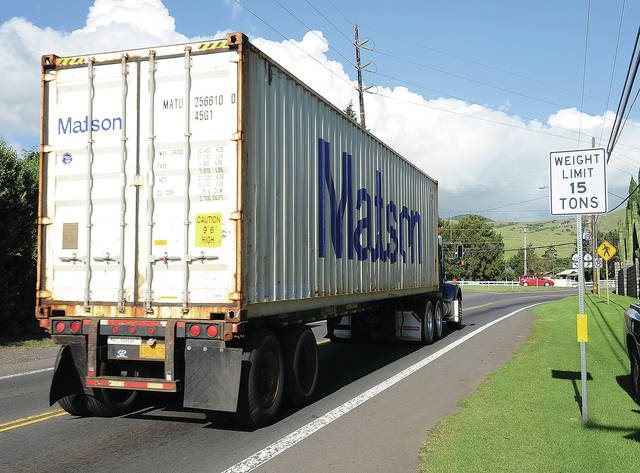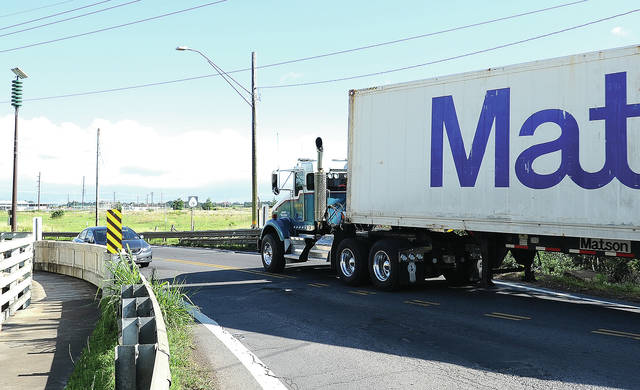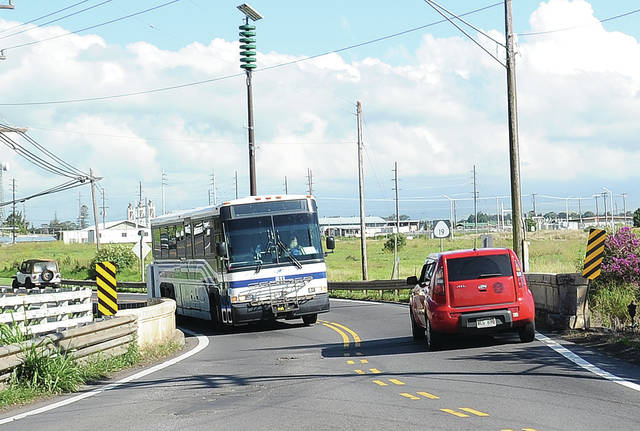KAILUA-KONA — Efforts to replace an 86-year-old bridge in Waimea are preparing to start up again.
The state Department of Transportation plans to advertise later this week a notice of interest to procure a design consultant to prepare new documents, design plans, project specs and cost estimates for replacing the Waiaka Stream Bridge, said Shelly Kunishige, DOT spokeswoman.
Meanwhile, the department said it will be revising the weight limit for the bridge to 18 tons after the agency announced a lower limit of 15 tons earlier this month after the state reassessed how it calculates weight restrictions to account for heavy truck loads.
An effort to replace the decades-old bridge, located close to the intersection of Kohala Mountain and Kawaihae roads in Waimea, has been on and off for years.
In 2011, the state released a draft environmental assessment to replace the 38-foot-long, 26-foot-wide bridge with one that’s 80 feet long and 53 feet wide featuring a shoulder/bike lane and raised sidewalk with railings. It estimated the project would cost about $8 million to $14 million, not including land acquisition costs.
At that time, an inspection of Waiaka Stream Bridge turned up a sufficiency rating of 26 out 100, where 100 means a sufficient bridge that meets current engineering design standards. That score meant the bridge was structurally deficient and in need of repair or assessment. The environmental assessment said that didn’t mean the bridge was unsafe to use.
A Hawaii DOT webpage that identifies the status of various infrastructure projects marked the bridge as being in “good” condition.
Kunishige said the website reflects only the physical bridge condition, while the sufficiency rating takes into account multiple criteria. The “26” rating was because of the bridge’s deck geometry, approach alignment and design capacity, she added, “but the bridge supports and deck themselves are sound.”
Then in 2015, DOT pulled the final environmental assessment and finding of no significant impact, because of “new circumstances and information that require additional studies,” according to a letter from the director released at the time.
In 2017, lawmakers approved a budget with $6 million for planning and land acquisition; it didn’t include money for actual construction. Of that sum, $4.8 million was federal funds, with the remaining $1.2 million coming from highway revenue bond funds, Kunishige said.
In the meantime, the department’s Hawaii District office is looking into potential short-term improvements to the bridge, such as widening the road on the approach, and will have the results of that investigation in May.
Earlier this month, the department announced a reduction in the weight restriction for that bridge and several others on Hawaii Island, Maui, Oahu and Kauai.
That included the limit for Waiaka Stream Bridge, which was reduced to 15 tons. Kunishige said a limit for the bridge was previously not posted. The limit for unposted bridges, she said, is 40 tons.
Kunishige said previous guidance was based on lower vehicle loads and weren’t the result of any structural changes to the bridges.
“As the federal guidance is updated and adjusted to account for newer, heavier vehicles, our calculations are being updated and adjusted as well,” she said.
In a letter to local officials and the manager of a local trucking company, DOT Highways Division Deputy Director Ed Sniffen said staff reanalyzed the bridge to consider average daily truck traffic and will be revising the weight limit to 18 tons.
The new limits won’t affect passenger vehicles, the agency said, which typically weigh about 2 tons. Other vehicles though, like emergency vehicles, buses and tractor-trailers may be affected by the change.
Kunishige said bridge design staff coordinated with the Department of Education, along with emergency services, county fire departments, public works departments and transit agencies about the posted weight restrictions and have pre-cleared many school buses and transit service vehicles.
Vehicles that aren’t cleared, she said, are eligible for annual permits to travel over the bridge.
While the department can’t offer annual permits to truck operators, whose loads change trip to trip, Kunishige said operators should contact the district office if they want to pre-clear their maximum load.











Ahhhhh another road widening project.
Should be interesting with the traffic flow.